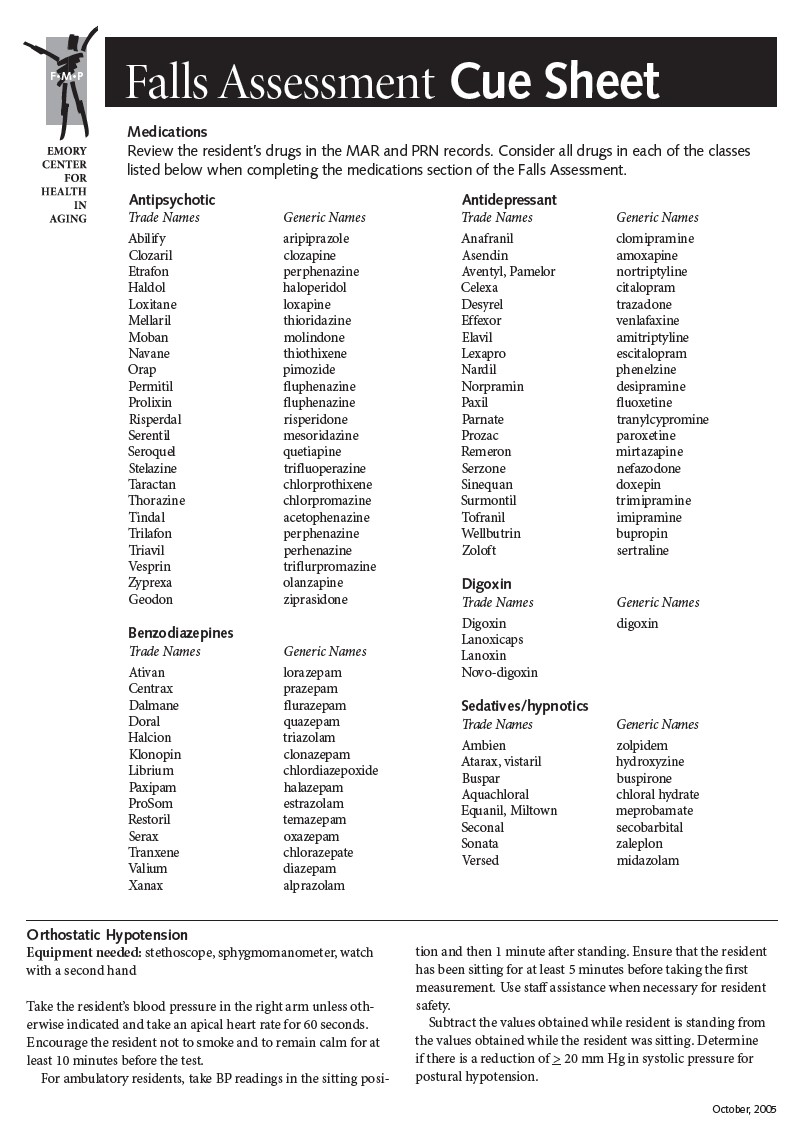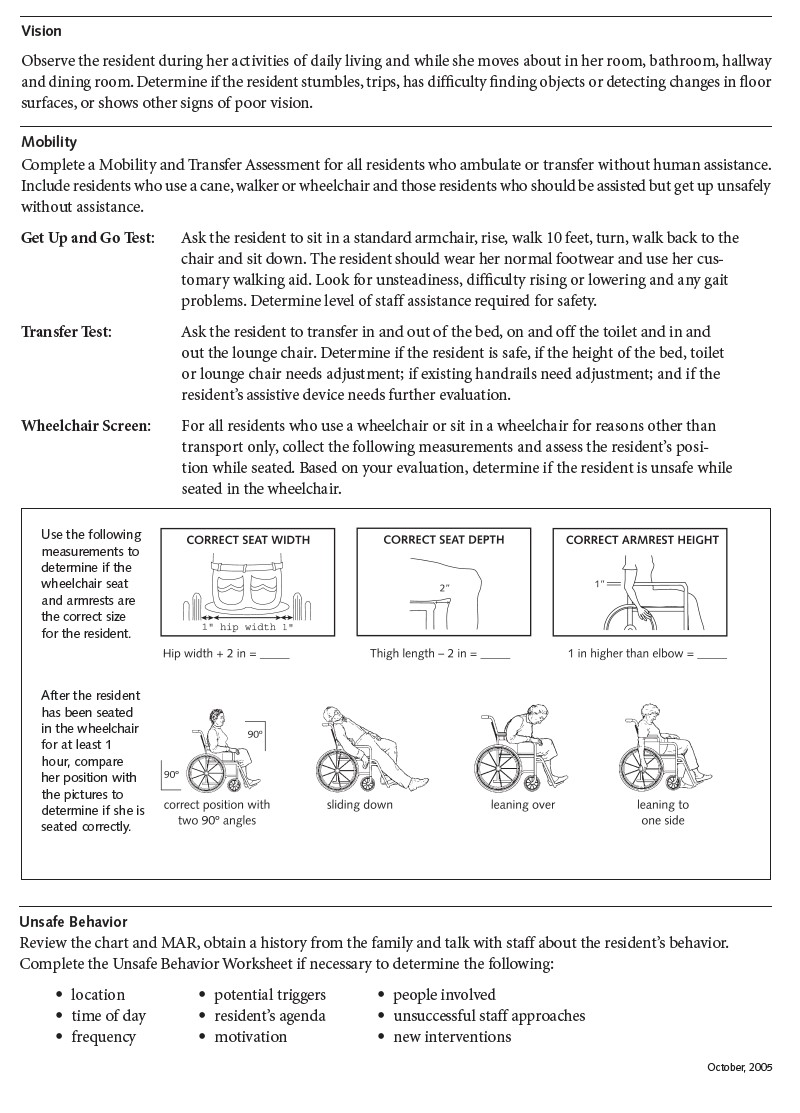

Text Description
Medications
Review the resident's drugs in the MAR and PRN records. Consider all drugs in each of the classes listed below when completing the medications section of the Falls Assessment.
| Antipsychotic | Antidepressant | ||
|---|---|---|---|
| Trade names | Generic names | Trade names | Generic names |
| Abilify Clozaril Etrafon Haldol Loxitane Mellaril Moban Navane Orap Permitil Prolixin Risperdal Serentil Seroquel Stelazine Taractan Thorazine Tindal Trilafon Triavil Vesprin Zyprexa Geodon |
aripiprazole clozapine perphenazine haloperidol loxapine thioridazine molindone thiothixene pimozide fluphenazine fluphenazine risperidone mesoridazine quetiapine trifluoperazine chlorprothixene chlorpromazine acetophenazine perphenazine perhenazine triflurpromazine olanzapine ziprasidone |
Anafranil Asendin Aventyl, Pamelor Celexa Desyrel Effexor Elavil Lexapro Nardil Norpramin Paxil Parnate Prozac Remeron Serzone Sinequan Surmontil Tofranil Wellbutrin Zoloft |
clomipramine amoxapine nortriptyline citalopram trazadone venlafaxine amitriptyline escitalopram phenelzine desipramine fluoxetine tranylcypromine paroxetine mirtazapine nefazodone doxepin trimipramine imipramine bupropin sertraline |
| Benzodiazepines | Digoxin | ||
| Trade names | Generic names | Trade names | Generic names |
| Ativan Centrax Dalman Doral Halcion Klonopin Librium Paxipam ProSom Restoril Serax Tranxene Valium Xanax |
lorazepam prazepam flurazepam quazepam triazolam clonazepam chlordiazepoxide halazepam estrazolam temazepam oxazepam chlorazepate diazepam alprazolam |
Digoxin Lanoxicaps Lanoxin Novo-digoxin |
digoxin |
| Sedatives/hypnotics | |||
| Trade names | Generic names | ||
| Ambien Atarax, vistrail Buspar Aquachloral Equanil, Miltown Seconal Sonata Versed |
zolpidem hydroxyzine busprione chloral hydrate meprobamate secobarbital zaleplon midazolam |
||
Orthostatic Hypotension
Equipment needed: stethoscope, sphygmomanometer, watch with a second hand.
Take the resident's blood pressure in the right arm unless otherwise indicated and take an apical heart rate for 60 seconds. Encourage the resident not to smoke and to remain calm for at least 10 minutes before the test.
For ambulatory residents, take BP readings in the sitting position and then 1 minute after standing. Ensure that the resident has been sitting for at least 5 minutes before taking the first measurement. Use staff assistance when necessary for resident safety.
Subtract the values obtained while resident is standing from the values obtained while the resident was sitting. Determine if there is a reduction of ≥20 mm Hg in systolic pressure for postural hypotension.
Vision
Observe the resident during his/her activities of daily living and while he/she moves about in his/her room, bathroom, hallway, and dining room. Determine if the resident stumbles, trips, has difficulty finding objects or detecting changes in floor surfaces, or shows other signs of poor vision.
Mobility
Complete a Mobility and Transfer Assessment for all residents who ambulate or transfer without human assistance. Include residents who use a cane, walker, or wheelchair and those residents who should be assisted but get up unsafely without assistance.
| Test | Description |
|---|---|
| Get Up and Go Test: | Ask the resident to sit in a standard armchair, rise, walk 10 feet, turn, walk back to the chair, and sit down. The resident should wear his/her normal footwear and use his/her customary walking aid. Look for unsteadiness, difficulty rising or lowering, and any gait problems. Determine level of staff assistance required for safety. |
| Transfer Test: | Ask the resident to transfer in and out of the bed, on and off the toilet, and in and out of the lounge chair. Determine if the resident is safe; if the height of the bed, toilet, or lounge chair needs adjustment; if existing handrails need adjustment; and if the resident's assistive device needs further evaluation. |
| Wheelchair Screen: | For all residents who use a wheelchair or sit in a wheelchair for reasons other than transport only, collect the following measurements and assess the resident's position while seated. Based on your evaluation, determine if the resident is unsafe while seated in the wheelchair. |
Use the following measurements to determine if the wheelchair seat and armrests are the correct size for the resident.
- Correct Seat Width: Hip width + 2 inches = _______
- Correct Seat Depth: Thigh length - 2 inches = _______
- Correct Armrest Height: 1 inch higher than elbow = _______
After the resident has been seated in the wheelchair for at least 1 hour, compare her position with the pictures to determine if she is seated correctly.
- Correct position with two 90º angles [Image shows woman sitting upright in wheelchair].
- Sliding down [Image shows man slumped and sliding down out of wheelchair].
- Leaning over [Image shows woman sitting bent forward in wheelchair].
- Leaning to one side [Image shows woman leaning with one arm dangling over wheelchair armrest].
Unsafe Behavior
Review the chart and MAR, obtain a history from the family, and talk with staff about the resident's behavior. Complete the Unsafe Behavior Worksheet if necessary to determine the following:
- Location.
- Time of day.
- Frequency.
- Potential triggers.
- Resident's agenda.
- Motivation.
- People involved.
- Unsuccessful staff approaches.
- New interventions.



